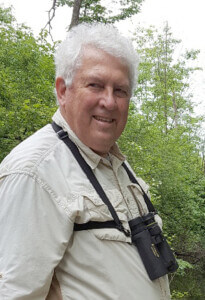RANGER STEVE’S NATURE NICHE
Tree Huggers
By Ranger Steve Mueller
 When I was a national park naturalist leading walks through a ponderosa pine forest at Bryce Canyon National Park, I worked to help people discover by exploration. One strategy was to lead them over a large fallen dead tree. They needed to sit on the tree and swing their legs to the other side.
When I was a national park naturalist leading walks through a ponderosa pine forest at Bryce Canyon National Park, I worked to help people discover by exploration. One strategy was to lead them over a large fallen dead tree. They needed to sit on the tree and swing their legs to the other side.
In the process some noticed the large meandering cavities where bark once hid them from view. Now with the bark fallen off, we could see tunnels where Cerambycid long-horned or Buprestid flat-headed wood boring beetle larva fed. Both of the beetle’s eggs are laid on dying or recently dead trees. The larvae fed on nutritious cambium tissue that lies between outer bark and inner xylem wood.
By creating an opportunity to discover the tunnels on their own, visitors asked questions that were more interesting to them than if I pointed out the tunnels. They also found straight line tunnels on some trees with small tunnels leading at right angles from a larger central tunnel. An adult Ips pine bark beetle laid eggs in the center line tunnel as it chewed its way along. Newly hatched young fed in rows next to each other as they ate outward from the center line. As they fed and grew, their tunnels became larger and finally stopped where they pupated. After emerging from their pupae they exited the tree to find a mate and lay eggs.
At another location I asked people to hug a ponderosa pine. The trees are beautiful, tall, and have mottled yellow, orange, and black bark with deep crevasses. Many were willing but I recall one man who strongly protested. He said he was not a tree hugger. Of course, I did not try to force him. When others complied, comments erupted that the trees smell like vanilla or butterscotch. People had discovered the unique odor without me telling them and they found different people had different smell descriptions. That was my goal. After a rain the forest is permeated with odor but when is it dry, one must get close to sense the smell.
The protesting gentleman walked to a tree, leaned toward it to smell, but refrained from touching or hugging the tree. It was the other field trip participants that got him to greet the tree and get to know it better.
 Ponderosa pine trees grow at about 8000 feet elevation at Bryce Canyon National Park. At lower elevations pinyon pines, Utah and Rocky Mountain junipers grow and in some areas Gambel’s oak creates a pygmy forest at the 6500-foot elevation. Douglas fir, white and Engelman spruces dominate at 9000 feet. There are nature niche details to discover in each forest type. Perhaps it will be tree odor, types of insects, growth patterns, or essential distance needed between trees for water, light, and nutrient gathering.
Ponderosa pine trees grow at about 8000 feet elevation at Bryce Canyon National Park. At lower elevations pinyon pines, Utah and Rocky Mountain junipers grow and in some areas Gambel’s oak creates a pygmy forest at the 6500-foot elevation. Douglas fir, white and Engelman spruces dominate at 9000 feet. There are nature niche details to discover in each forest type. Perhaps it will be tree odor, types of insects, growth patterns, or essential distance needed between trees for water, light, and nutrient gathering.
Another “tree hugging” activity to get people closer to trees is to have them put their backs against a big tree shoulder to shoulder. I count how many people it takes to surround the tree. Because they are in circle, I keep walking in a circle counting to a higher number until someone stops me and says, “You already counted me.” Then I count again but stop when I have walked around the tree once. It keeps it fun and involves participants.
It helps to be a tree hugger or wildflower gardener to get close and intimate to discover the secrets of those of the forest. Spend time helping others engage life that abounds in nearby trees or gardens.
I am thankful Wild Ones members have maintained Ody Brook’s wildflower gardens the past three years since oncologists told me it is too dangerous for me to garden because I am not fungus protected. I hope Wild Ones will continue to maintain Ody Brook Nature Sanctuary gardens and enjoy the trails and Spring wildflowers.
The most recent chemo has been failing. A new Car T cell treatment holds promise. My blood cells were harvested and sent to a lab a genetic modification to attack cancer cells. After weeks of growth, cells were infused back into me. While hospitalized, Karen needed to be with me 24/7 to watch for serious effects. Some have minimal side effects but others become comatose and die (unlikely). The risks are significant but benefits are greater and worth the risks. I hope to be back on the trails by late April when Spring flowers are peeking.
Natural history questions or topic suggestions can be directed to Ranger Steve (Mueller) at [email protected] – Ody Brook Nature Sanctuary, 13010 Northland Dr. Cedar Springs, MI 49319 or call 616-696-1753.
Written for Wild Ones, April 2021
Ponderosa Pine photo and banner detail : Dave Powell, USDA Forest Service (retired), Bugwood.org
